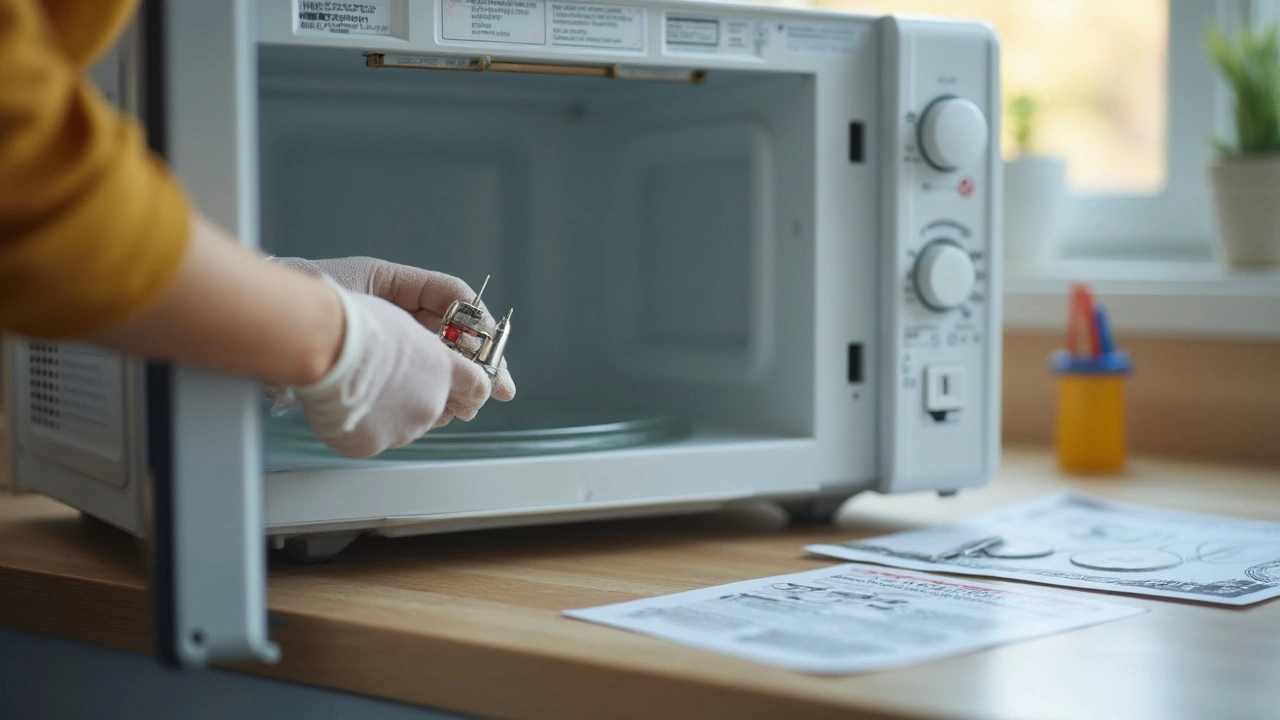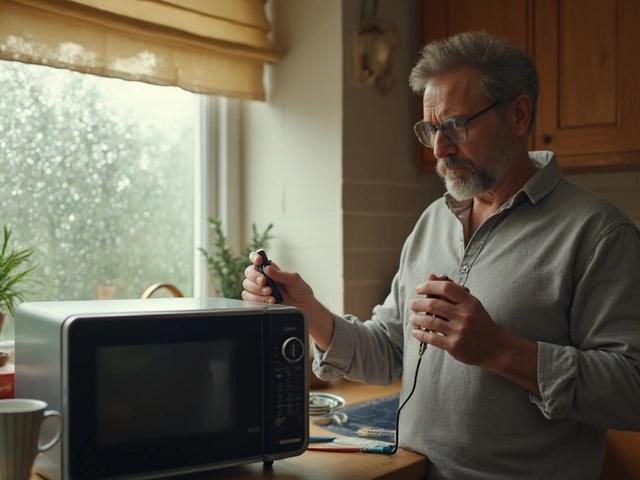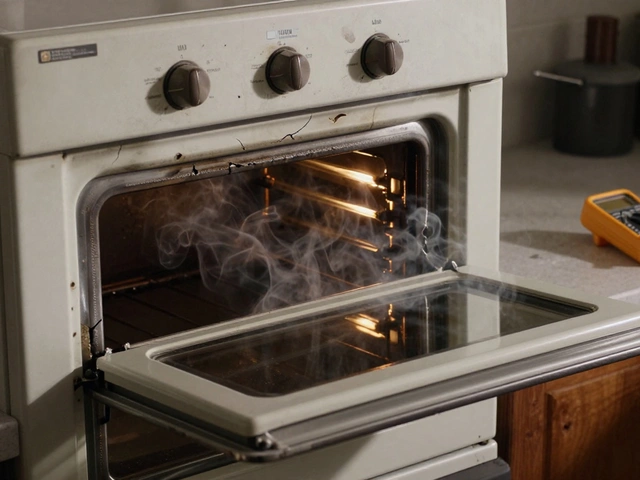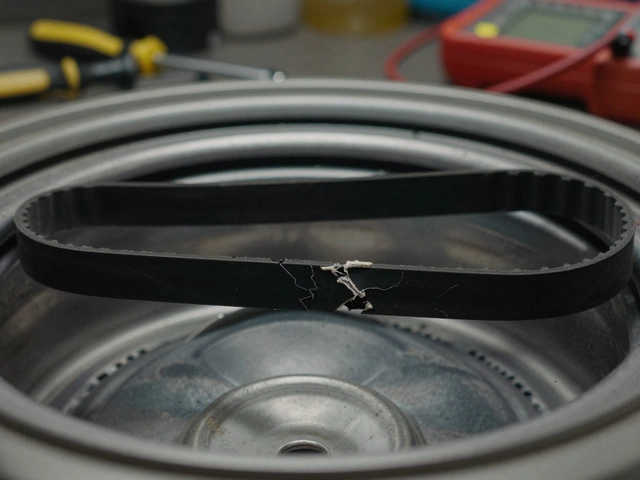Your microwave goes silent and there’s no light, no beep, nothing—this isn’t just annoying, it can totally throw off your routine. Before you think about tossing it or calling a pro, there’s a good chance the problem is a simple blown fuse. And yes, you can actually check and maybe even fix it yourself, as long as you keep things safe.
The fuse is there to protect the microwave’s guts from electrical overloads or short circuits. If it’s blown, the microwave won’t turn on at all—no matter how many times you push the start button. Knowing how to check for a blown fuse is a handy trick. It can save you cash and a trip to the appliance store. Got a screwdriver? Curious what’s going on inside? Stick with me, and I’ll show you exactly how to figure this out—and what to do about it if your fuse really is toast.
- Why Your Microwave Might Stop Working
- What Exactly Is a Microwave Fuse?
- How to Spot Signs of a Blown Fuse
- How to Access and Test Your Microwave Fuse
- Replacing the Fuse: The Right Way
- When It's More Than Just the Fuse
Why Your Microwave Might Stop Working
When a microwave goes cold and unresponsive, it’s usually down to a handful of causes. The most common culprit is a blown fuse. Fuses are like bodyguards—if something risky happens with the power, they kill the circuit to save your microwave’s other parts. But let’s not skip other possible reasons.
First, always check if the microwave is actually plugged in. Sounds basic, but sometimes a loose cord or an outlet tripped by another appliance can be the whole story. Next, think about the door—microwaves have safety switches so they only run if the door is closed tight. A worn-down door latch or faulty switch will completely shut things down with zero warning.
- Microwave fuse blown: Power surges or slamming the microwave door too hard are top reasons the fuse might go.
- Burnt-out thermal fuse: If your microwave’s gotten overheated inside, a small thermal fuse could pop and stop the whole machine.
- Faulty door switch: If the door doesn’t latch just right, nothing else will work.
- Bad control board: Occasionally it’s the electronics inside, meaning buttons or screens stop responding. This is rare compared to a simple blown fuse.
- Worn-out magnetron: This is what actually heats your food. If it’s shot, the microwave might run but nothing warms up. If it’s totally dead, sometimes the machine won’t even start.
If your microwave won’t turn on at all—no lights, no sounds—the fuse is usually the first thing to check. It’s a quick win if that’s the problem. If the inside light turns on, but the turntable won’t spin or the food stays cold, the fuse probably isn’t it—you might be dealing with a trickier part.
What Exactly Is a Microwave Fuse?
A microwave fuse is a small safety device that cuts off power if something goes wrong inside your microwave—like a sudden power surge or a major electrical fault. We’re talking about a component that’s usually about the size of a pencil eraser or a small tube, but without it, your microwave’s electronics would be toast in a hurry when wiring or parts overload.
The main job of the fuse is to shut down your microwave before things get dangerous. Most household microwaves use ceramic or glass fuses tucked away just inside the outer cover. You’ll find them rated anywhere from 15 to 20 amps for standard kitchen models, and the rating is usually printed right on the fuse itself. If your microwave is totally dead (like, not even the clock lights up), the fuse is the microwave fuse you want to check first.
Microwave fuses work just like car or garage fuses—if too much electricity flows through, the thin wire inside melts or snaps, breaking the circuit and stopping all power. This isn’t just about fixing a dead microwave—this is about keeping your kitchen safe.
| Type of Microwave Fuse | Common Amp Rating |
|---|---|
| Ceramic | 15A, 20A |
| Glass Tubular | 15A, 20A |
If you ever open up your microwave and see a small tube near where the power cord connects internally, you’ve probably found the fuse. It’s never meant to be reset like a breaker; once it’s blown, swapping in a new one is your only option. Don’t try to “fix” a blown fuse—replace it with the same type and rating every single time.
How to Spot Signs of a Blown Fuse
So your microwave isn’t doing anything—no lights, no fans, no familiar humming, not even a number on the clock. That’s usually the first big hint that the fuse could be blown. While several things can stop a microwave from working, a fuse issue is one of the most common reasons the whole thing suddenly goes dead.
You don’t need to be an engineer to catch obvious signs. If the microwave fuse is blown, here’s what usually happens:
- Microwave is completely dead: No display, no sound, no response when you press buttons.
- No interior light: Even when you open the door, nothing flickers on.
- No power to the fan or turntable: Press start and nothing spins or whirs.
- No beeps or error codes: Microwaves sometimes beep for everything, but here—silence.
One weird thing—if your microwave shares a wall outlet with other appliances and they’re all working fine, that’s a stronger clue the problem is inside the microwave, not with your kitchen wiring or the house fuse box.
It’s worth checking your kitchen outlet with another small appliance, just to make sure the outlet isn’t the problem. Microwaves draw a lot of power, so a tripped circuit breaker could also fool you into thinking it’s a busted fuse.
| Symptom | Possible Cause |
|---|---|
| No power, lights, or sound | Blown microwave fuse |
| Outlet not working | Tripped house breaker or bad outlet |
| Error code only | Door switch or control panel issue |
Don't forget: microwaves can hold an electrical charge even when unplugged. If the display or light flickers at all, the fuse probably isn’t completely toast yet—so check that first before digging deeper.

How to Access and Test Your Microwave Fuse
First things first—you have to unplug your microwave before doing anything else. Don’t skip this. Even when the microwave is off, there’s still enough juice inside to give you a nasty shock. Once you’re sure it’s unplugged, you’re good to go.
The fuse is usually hiding behind the main outer cover, which means you’ll need a screwdriver to pop off the microwave’s case. Most microwaves use Phillips screws, and you’ll typically find them at the back. Some models may also have hidden screws along the sides or under plastic tabs.
- Unplug the microwave—safety first, always.
- Move it to a safe spot with good lighting, preferably a solid worktable.
- Remove the turntable and anything loose inside.
- Take out all the screws holding the outer case, then carefully slide or lift off the case. Try not to force anything—cases bend easily.
With the cover off, you’ll spot the fuse. It looks like a small glass tube with metal ends, or sometimes a white ceramic tube. Most microwaves put the fuse near where the cord comes in, close to a few wires and the control board. If your owner’s manual shows a diagram, follow it. Don’t guess if you’re not sure which part is the fuse.
Now, on to testing. You need a cheap multimeter (you can grab one for under $15 if you don’t have it already). Set it to the continuity or resistance setting. Touch the probes to each end of the fuse:
- If the fuse is good, you’ll hear a beep (on continuity mode) or see a number close to zero ohms.
- If it’s blown, nothing happens—no beep, and the number isn’t close to zero.
Here’s a quick comparison of fuse types and where to look for them:
| Fuse Type | Visual Description | Common Location |
|---|---|---|
| Glass Tube | See-through, you can spot the filament inside | Near the power input or control board |
| Ceramic Tube | Solid white, can’t see inside | Power wiring area, often near relays |
Don’t skip double-checking your results. Sometimes a fuse can look fine but still be blown inside. Always go by the multimeter.
Replacing the Fuse: The Right Way
Alright, so your microwave fuse is actually the problem. Here’s how to swap it out—and get your trusty appliance running again. Safety first though. The danger with microwaves isn’t just the power cord; even unplugged, the capacitor can hold a nasty charge. If you’re unsure, it’s smarter to call a tech, but if you’re set on doing it yourself, follow these clear steps.
- Unplug the microwave completely. Double-check to be sure. Never skip this.
- Wait at least 15 minutes to let any stored energy from the capacitor drain out. You can even check with a voltage tester if you have one.
- Remove the outer cover (usually several screws on the back and sides). Keep the screws somewhere safe.
- Find the fuse. It’s often a small cylinder or glass tube, located near where the power cord enters or close to the control board. Some are ceramic, some are glass—take a close look.
- Carefully pop out the bad fuse. Don’t use metal tools! Fingers are best. Take note of the fuse’s specs—look for numbers printed on it such as “20A 250V.”
- Buy a replacement fuse with the same rating. Don’t go with a higher or lower amp—this risks either blowing again or, worse, damaging your microwave.
- Install the new one, clip everything back together, and put the cover back on tight. Plug the microwave in and test it.
If you’re curious, most microwaves use a fuse rated for 15 to 20 amps and 250 volts, but check your old one to be sure. Going with the wrong rating isn’t just risky—it can void your warranty or start a fire.
A quick glance at common microwave fuse ratings:
| Brand | Typical Fuse Rating |
|---|---|
| Panasonic | 20A 250V |
| Samsung | 15A 250V |
| LG | 20A 250V |
| GE | 15A 250V |
A microwave fuse is usually pretty cheap—just a couple of bucks online or at hardware stores. Don’t let anyone sell you something fancier than you need. Double-check everything’s reattached before plugging it in, and if you hear odd noises or it’s still dead, don’t keep trying. Sometimes a blown fuse is just a sign of a deeper problem.
When It's More Than Just the Fuse
So you swapped out the fuse, and your microwave’s still as dead as a brick. That’s when you know the problem goes deeper. A blown fuse is common, but it’s not always the only thing wrong. Microwaves are a bundle of complicated parts—some of them can fail in ways that look a lot like a simple fuse issue.
If your microwave flat-out refuses to turn on after putting in a new fuse, here’s what to look at next:
- Door Switches: If the microwave thinks the door is open, it won't do anything. Sometimes, the little door switches wear out or snap out of place. A multimeter can help test them to see if they're making a proper connection when the door shuts.
- Thermal Fuse or Cut-Out: There’s usually another fuse—the thermal one—meant to shut things down if the inside gets way too hot. If it’s blown, the microwave won’t start. This is different from the main fuse but causes the same dead silence.
- Control Board: Ever noticed the clock isn’t showing up, even with a new fuse? It might be the control board itself. This part can fail from a power surge or just age, and fixing it usually means replacing the entire board.
- Magnetron or High-Voltage Parts: The magnetron (what actually cooks your food) or the high-voltage capacitor or diode can burn out, too. If your machine lights up and turns, but just doesn’t heat, chances are something in this set died. If your fuse keeps blowing after replacement, these components could be the cause.
Here’s a quick way to spot what you’re dealing with:
| Problem | How it Shows Up | Likely Part |
|---|---|---|
| No power at all (even with new fuse) | Won’t turn on, no lights, no sounds | Door switches, thermal fuse, control board |
| Turns on, but doesn’t heat | Light and fan work, but food stays cold | Magnetron, diode, capacitor |
| Keeps blowing new fuses | Immediate pop or shutoff | Shorted part inside: usually magnetron, capacitor, or wiring |
Here’s the thing: anything involving the magnetron, capacitor, or internal wiring isn’t a DIY fix for most people. Those parts can carry dangerous voltages—even after being unplugged. So, if the microwave fuse is good, but the trouble sticks around, it’s probably time to call in a pro. A repair guy can test high-voltage parts safely and get to the real culprit without you risking a nasty shock.
Don’t keep throwing in new fuses hoping for a miracle. That’s like changing lightbulbs when the power is out—you’re missing the real fix. If your troubleshooting takes you past the fuse, sometimes stepping back and letting a technician handle it is the smartest (and safest) move.









